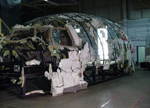In-Flight Firefighting Preparedness Needs Improvement, NTSB Says
By Sean Broderick/AviationNow.com
08-Jan-2002 3:12 PM U.S. EST

U.S. airline flight and cabin crews need better training on fighting hidden in-flight fires, and areas that may hide fires must become more accessible, the National Transportation Safety Board (NTSB) concluded after reviewing several events and airline training programs.
The review triggered six recommendations to the U.S. Federal Aviation Administration in a Jan. 4 letter (click here for the letter in .pdf form). NTSB wants, among other things, better training on when to use fire extinguishers and additions of panels on cabin surfaces that would permit access to hard-to-reach areas.
Regulators, including FAA, have made great strides in improving aircraft fire safety training and procedures following a June 1983 Air Canada in-flight fire that killed 23. But probes of several recent incidents show more improvement is needed, NTSB said.
In two incidents since 1998 -- involving a Delta MD-88 and an AirTran DC-9 -- pilots and flight attendants debated whether to use Halon fire extinguishers on areas where smoke was coming from because, unsure of each fire's seriousness, they feared the chemical would do more harm than good. In a third, in 2000, an above-ceiling fire was rapidly blistering ceiling panels in an American MD-82's main cabin. The fire was put out only after a passenger pulled a knife from his carry-on bag and cut a hole in the panels, giving an extinguisher-toting flight attendant a clear shot at the flames. Each incident ended with safe emergency landings and evacuations, with only a few minor injuries reported.
An FAA advisory circular (AC) discusses the potential hazards of Halon on humans. The board believes the AC doesn't emphasize that an in-flight fire is invariably more dangerous, however, and wants FAA to issue a revised AC clarifying the point. The board also believes that flight crew firefighting courses required under FAR 121 should be intensified. At most airlines, the required fire extinguishing drill consists of putting out an open flame. Such training doesn't teach crewmembers on how to locate and battle a hidden fire, such as in a cargo compartment or above the ceiling, NTSB points out.
Current security regulations banning knives and other sharp instruments mean the odds of finding a tool to cut one's way to an in-flight fire are not good. Even when knives were readily available on flights, however, fires propagating in hard-to-access spots posed numerous problems. Swissair 111 and ValuJet 592 are two examples of the most dire consequences when such fires are not contained.
NTSB wants FAA to develop "procedures or airplane modifications" that will help crews gain access behind panels to expose fires on in-service planes. New aircraft should be equipped with more panels, ports, or other means to accomplish the same thing, the board said.
See Also:
NTSB Recommendations A-01-83 to -87 (.pdf)